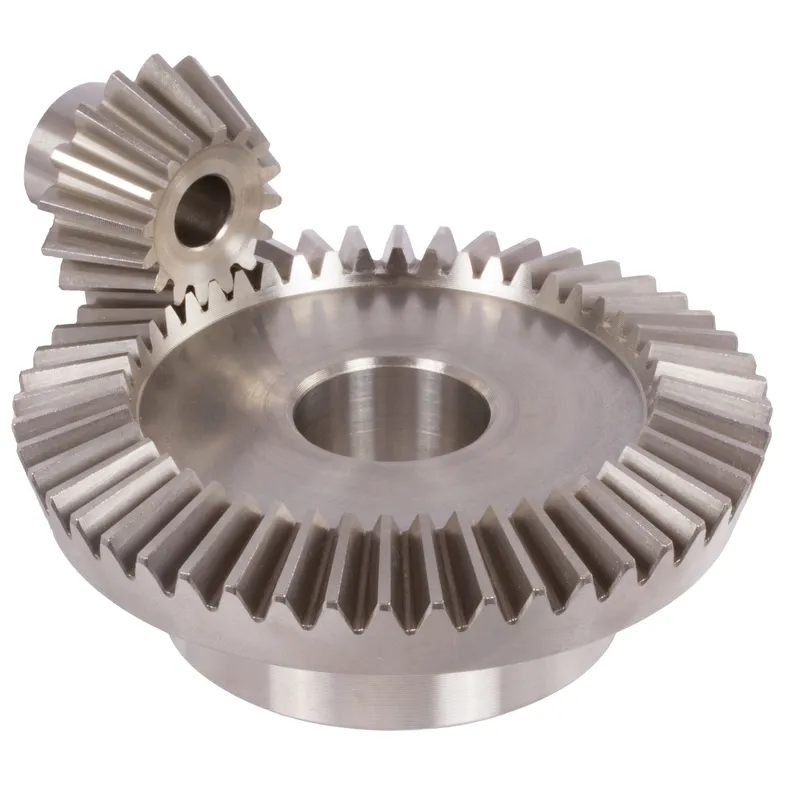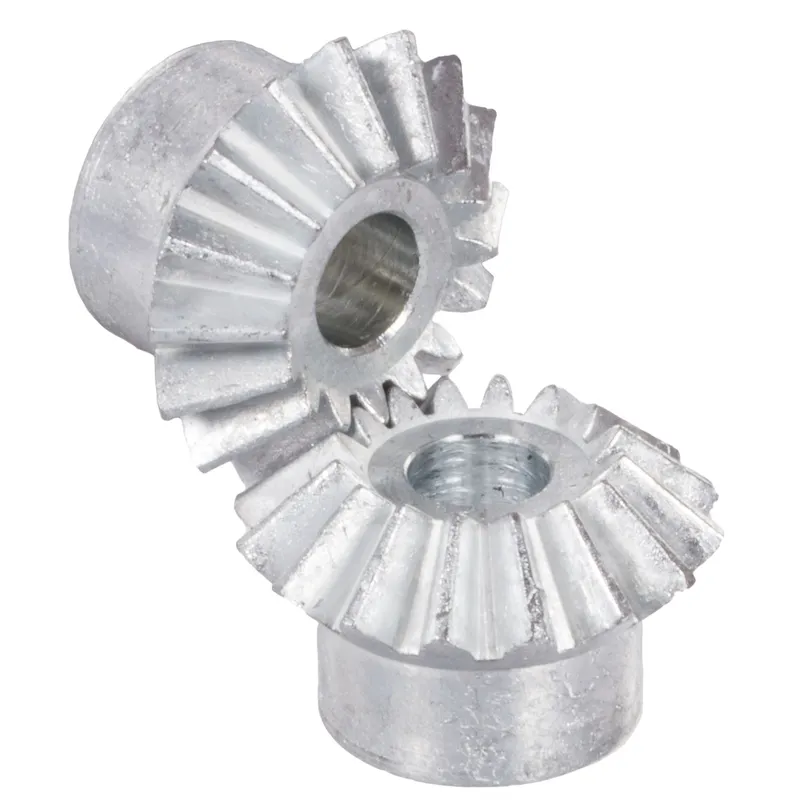Brass Bevel Gears Ratio 1:1 – 4:1 Straight-Tooth System
The brass bevel gears ratio 1:1 – 4:1 straight-tooth system refers to a mechanical gear system designed for transmitting rotational motion between non-parallel shafts, typically at a 90-degree angle. These gears are made from brass, a durable and corrosion-resistant material, making them suitable for high-performance applications requiring longevity and precision. These brass bevel gears are widely used in machinery, robotics, and automotive systems where accurate angular transmission is essential.
The brass bevel gears ratio 1:1 - 4:1 straight-tooth system refers to a mechanical gear system designed for transmitting rotational motion between non-parallel shafts, typically at a 90-degree angle. These gears are made from brass, a durable and corrosion-resistant material, making them suitable for high-performance applications requiring longevity and precision.
The straight-tooth design features uniformly spaced teeth that are oriented radially along the cone-shaped surface of the gear. This configuration ensures smooth and efficient power transfer with minimal backlash. The ratio range of 1:1 to 4:1 describes the relationship between the number of teeth on the driving (input) gear and the driven (output) gear. For example, a 4:1 ratio implies that the driving gear completes four rotations for each rotation of the output gear, enabling speed reduction or torque amplification.
These gears are widely used in machinery, robotics, and automotive systems where accurate angular transmission is essential. Their brass construction also provides excellent thermal conductivity and resistance to wear, making them ideal for moderate-load applications.
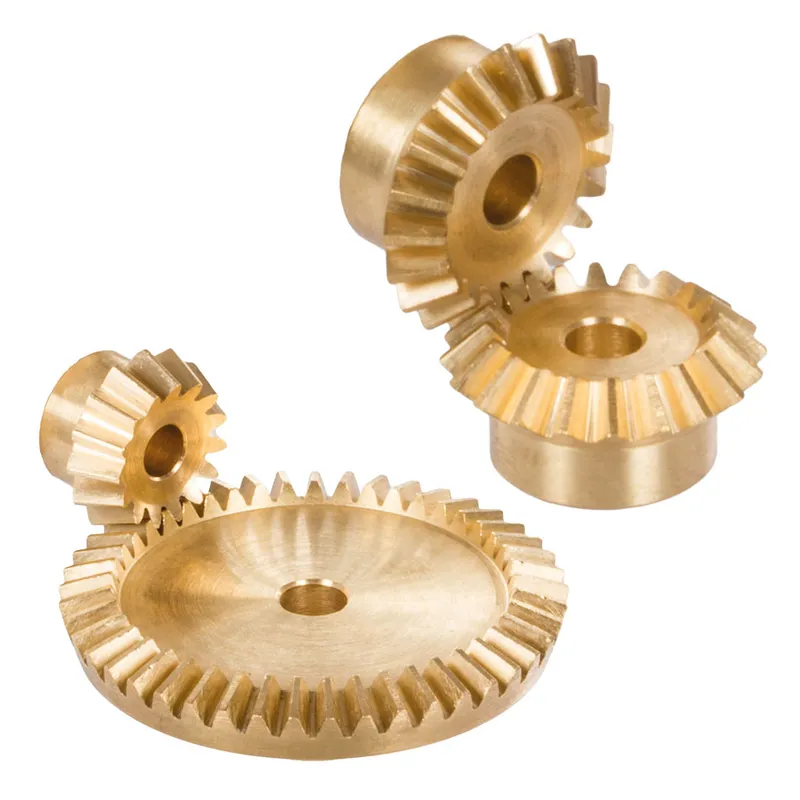
Brass Bevel Gear Ratio 1:1
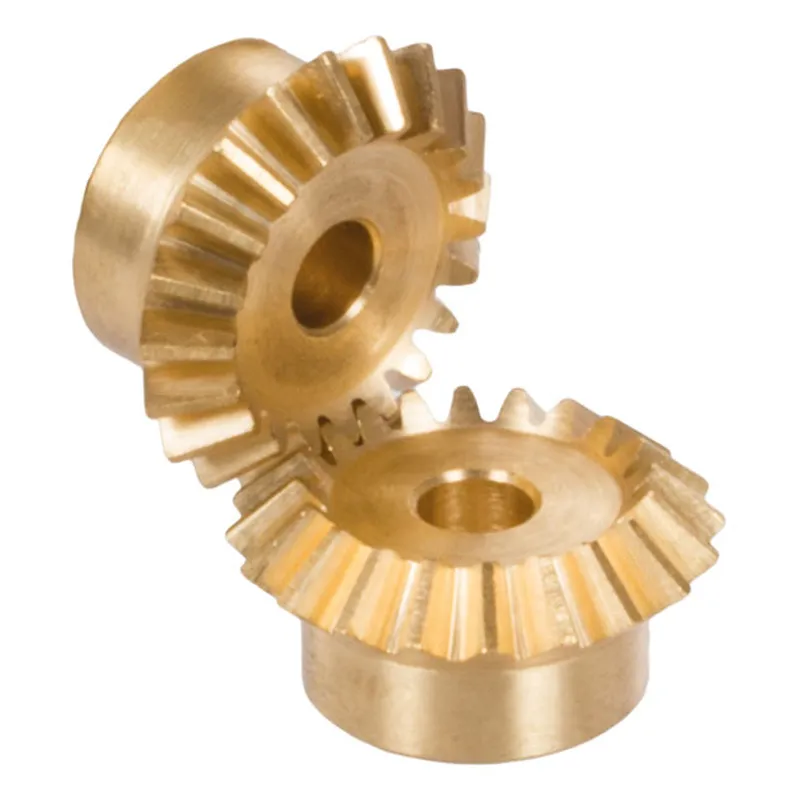 | 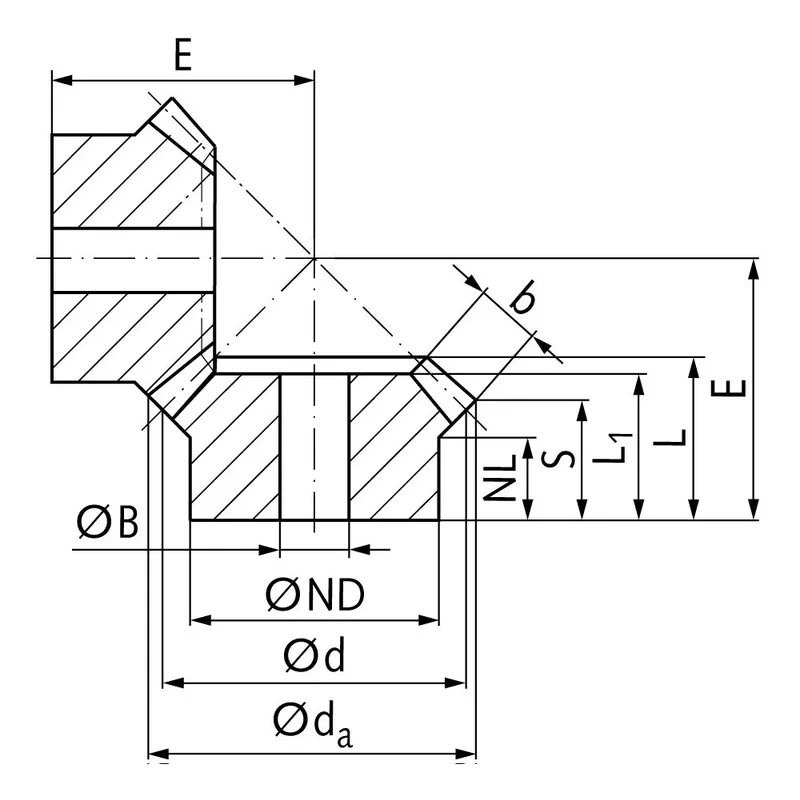 |
| Module | Number of teeth | da | d | ND | NL | L1 | L | S | b | BH7 | E | Torque* | Weight |
| mm | mm | mm | mm | mm | mm | mm | mm | mm | mm | Ncm | g | ||
| 0,5 | 15 | 8,2 | 7,5 | 6 | 5 | 6,3 | 7,3 | 6,1 | 2 | 3 | 9,5 | 0,9 | 1 |
| 0,5 | 20 | 10,7 | 10 | 8 | 4 | 7 | 7 | 5 | 3 | 4 | 9,7 | 1,9 | 1 |
| 0,5 | 24 | 12,7 | 12 | 8 | 4 | 6,4 | 7 | 5 | 3 | 4 | 10,7 | 3,0 | 3 |
| 0,5 | 30 | 15,7 | 15 | 10 | 4 | 7,5 | 8,5 | 6,6 | 3 | 4 | 13,7 | 5,3 | 4 |
| 0,5 | 36 | 18,7 | 18 | 12 | 5 | 9 | 10,1 | 8 | 3 | 4 | 16,7 | 8,2 | 10 |
| 0,5 | 40 | 20,7 | 20 | 12 | 5 | 8,5 | 9,5 | 7,5 | 3 | 4 | 17,1 | 10,6 | 10 |
| 0,5 | 50 | 25,7 | 25 | 14 | 5 | 8,5 | 9,5 | 7,5 | 3 | 4 | 19,6 | 18,0 | 16 |
| 1 | 12 | 13,0 | 12 | 8 | 5 | 8,5 | 9,6 | 7,7 | 3 | 5 | 13,2 | 5,0 | 3 |
| 1 | 16 | 17,4 | 16 | 12 | 5 | 9 | 10,3 | 7,8 | 4 | 5 | 15,1 | 6,0 | 9 |
| 1 | 20 | 21,4 | 20 | 15 | 5 | 9 | 10,4 | 7,8 | 4 | 5 | 17,1 | 13,0 | 15 |
| 1 | 25 | 26,4 | 25 | 16 | 6,7 | 11,5 | 13 | 9,7 | 5 | 5 | 21,5 | 26,0 | 26 |
| 1 | 30 | 31,4 | 30 | 16 | 7 | 11,5 | 13,1 | 9,7 | 5 | 5 | 24,0 | 40,0 | 33 |
| 1 | 36 | 37,4 | 36 | 16 | 7 | 11,5 | 13 | 9,6 | 5 | 5 | 26,9 | 62,0 | 43 |
| 1 | 40 | 41,4 | 40 | 16 | 8 | 12,5 | 14 | 10,6 | 5 | 5 | 29,9 | 79,0 | 53 |
| 1 | 50 | 51,4 | 50 | 16 | 8 | 12,5 | 14 | 10,6 | 5 | 6 | 34,9 | 130,0 | 76 |
| 1 | 60 | 61,4 | 60 | 16 | 8 | 12,5 | 14,1 | 10,6 | 5 | 6 | 39,9 | 197,0 | 110 |
Brass Bevel Gear Ratio 1.5:1
 |  |
| Module | Number of teeth | da | d | ND | NL | L1 | L | S | b | BH7 | E | Torque* | Weight |
| mm | mm | mm | mm | mm | mm | mm | mm | mm | mm | Ncm | g | ||
| 0,5 | 20 | 11,0 | 10 | 8 | 3,5 | 6,5 | 7,1 | 4,7 | 3 | 4 | 11,9 | 2,4 | 2 |
| 0,5 | 30 | 15,4 | 15 | 10 | 4 | 6 | 7 | 5,4 | 3 | 4 | 10,1 | 3,6 | 4 |
| 1 | 20 | 22,1 | 20 | 15 | 5 | 10 | 11,1 | 7,2 | 5 | 5 | 21,5 | 18,0 | 16 |
| 1 | 30 | 30,8 | 30 | 16 | 5 | 9 | 10,9 | 8,3 | 5 | 5 | 17,7 | 27,0 | 28 |
Brass Bevel Gear Ratio 2:1
 |  |
| Module | Number of teeth | da | d | ND | NL | L1 | L | S | b | BH7 | E | Torque* | Weight |
| mm | mm | mm | mm | mm | mm | mm | mm | mm | mm | Ncm | g | ||
| 0,5 | 20 | 11,2 | 10 | 8 | 4 | 7 | 7,5 | 5,0 | 3 | 4 | 14,65 | 2,7 | 2 |
| 0,5 | 40 | 20,3 | 20 | 12 | 5 | 7,5 | 8,4 | 7,1 | 3 | 4 | 11,83 | 5,4 | 8 |
| 1 | 15 | 17,4 | 15 | 12,5 | 4,5 | 9 | 10,1 | 5,8 | 5 | 5 | 20,2 | 9,4 | 9 |
| 1 | 30 | 30,6 | 30 | 16 | 5 | 9 | 10,8 | 8,8 | 5 | 5 | 15,7 | 18,8 | 27 |
| 1 | 20 | 22,4 | 20 | 15 | 5 | 10 | 11,1 | 6,8 | 5 | 5 | 26,2 | 20,6 | 17 |
| 1 | 40 | 40,6 | 40 | 16 | 8 | 12 | 13,8 | 11,7 | 5 | 6 | 21,1 | 41,2 | 50 |
Brass Bevel Gear Ratio 2.5:1
 |  |
| Module | Number of teeth | da | d | ND | NL | L1 | L | S | b | BH7 | E | Torque* | Weight |
| mm | mm | mm | mm | mm | mm | mm | mm | mm | mm | Ncm | g | ||
| 0,5 | 20 | 11,3 | 10 | 8 | 4 | 7 | 7,6 | 4,9 | 3 | 4 | 17,1 | 3,0 | 3 |
| 0,5 | 50 | 25,2 | 25 | 14 | 5 | 7 | 7,8 | 6,8 | 3 | 4 | 11,5 | 7,5 | 12 |
Brass Bevel Gear Ratio 3:1
 |  |
| Module | Number of teeth | da | d | ND | NL | L1 | L | S | b | BH7 | E | Torque* | Weight |
| mm | mm | mm | mm | mm | mm | mm | mm | mm | mm | Ncm | g | ||
| 0,5 | 15 | 8,8 | 7,5 | 6 | 3,7 | 6,5 | 7 | 4,3 | 3 | 3 | 15,3 | 1,5 | 1 |
| 0,5 | 45 | 22,7 | 22,5 | 12 | 5 | 7,5 | 8,4 | 7,5 | 3 | 4 | 11,0 | 4,5 | 11 |
| 1 | 15 | 17,7 | 15 | 13 | 5 | 10 | 11,1 | 6,5 | 5 | 5 | 28,5 | 11,0 | 10 |
| 1 | 45 | 45,4 | 45 | 16 | 8 | 12,5 | 14,7 | 13,2 | 5 | 6 | 20,2 | 33,0 | 68 |
Brass Bevel Gear Ratio 4:1
 |  |
| Module | Number of teeth | da | d | ND | NL | L1 | L | S | b | BH7 | E | Torque* | Weight |
| mm | mm | mm | mm | mm | mm | mm | mm | mm | mm | Ncm | g | ||
| 1 | 15 | 17,8 | 15 | 13 | 5,5 | 10 | 11 | 6,3 | 5 | 5 | 35,9 | 12,2 | 10 |
| 1 | 60 | 60,3 | 60 | 16 | 8 | 12,5 | 14,6 | 13,6 | 5 | 6 | 20,5 | 48,8 | 110 |
Brass Bevel Gear Advantages and Disadvantages
Brass bevel gears with a straight-tooth system, commonly used in ratios like 1:1 to 4:1, offer distinct advantages and disadvantages in mechanical applications. These conical gears, designed to transmit motion between intersecting shafts (typically at 90 degrees), are valued for specific properties but also face limitations.
Advantages:
- Corrosion Resistance: Brass, often an alloy like Ms58 (CuZn39Pb3), resists corrosion effectively, making these gears suitable for environments exposed to moisture or mild chemicals, such as marine or industrial settings. This durability extends service life compared to steel gears in corrosive conditions.
- Machinability and Cost-Effectiveness: Brass is softer and easier to machine than steel, allowing for precise tooth cutting and reduced production costs. The straight-tooth design further simplifies manufacturing compared to spiral or helical bevel gears, making brass bevel gears economical for small-scale or low-speed applications.
- Low Friction and Self-Lubrication: Brass has a lower friction coefficient than many metals, reducing wear during operation. Its slight self-lubricating properties minimize the need for frequent maintenance, ideal for applications like hand tools, clocks, or mechanical instruments.
- Aesthetic Appeal: Brass gears have a polished, golden appearance, making them desirable for decorative or visible mechanisms, such as in antique machinery or display models.
- Good Conductivity: In applications requiring electrical or thermal conductivity, brass performs better than ferrous metals, though this is niche.
Disadvantages:
- Lower Strength: Brass is softer than steel or iron, limiting its use in high-torque or high-speed applications. Straight-tooth brass bevel gears are prone to deformation or wear under heavy loads, restricting them to lighter-duty tasks.
- Noise and Vibration: The straight-tooth design engages teeth abruptly, causing noise and vibration at higher speeds. This makes them unsuitable for precision or high-speed machinery, where spiral bevel gears are preferred.
- Limited Load Capacity: Compared to steel or hardened alloys, brass gears have lower tensile strength, reducing their ability to handle significant mechanical stress, which can lead to tooth failure in demanding applications.
- Wear Over Time: Despite brass’s low friction, continuous operation can lead to gradual wear, especially in poorly lubricated systems, necessitating eventual replacement.
- Temperature Sensitivity: Brass has a lower melting point than steel, making it less suitable for high-temperature environments where thermal expansion or softening could occur.
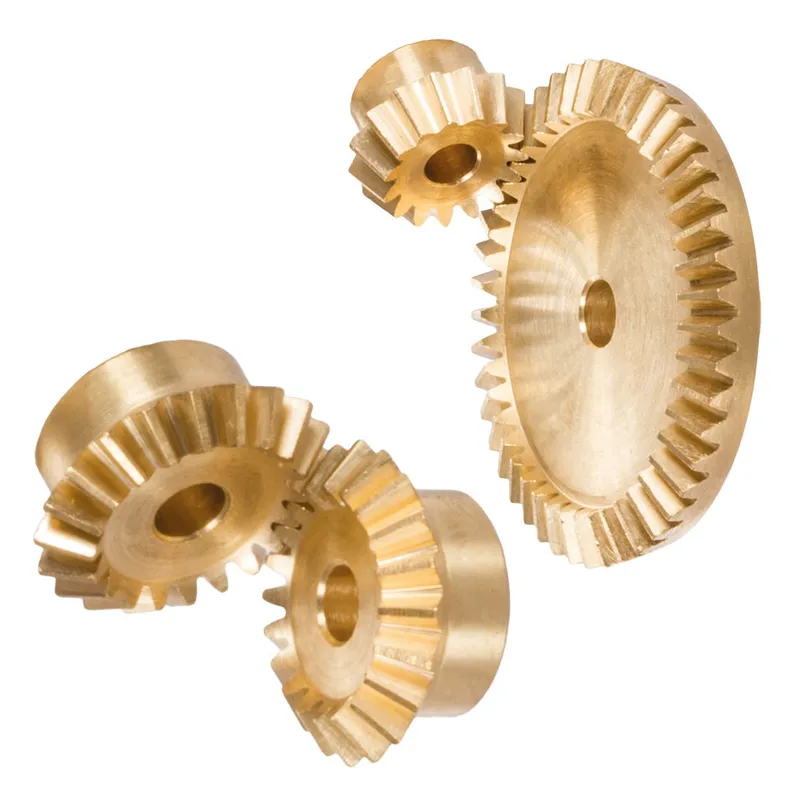
Applications of Brass Bevel Gears
- Automotive Industry
Brass bevel gears are used in automotive systems, particularly in differential drives, to transmit power at 90-degree angles between the driveshaft and the wheels. Their corrosion resistance and smooth operation ensure durability and quiet performance in vehicles. - Marine Equipment
In marine applications, brass bevel gears are essential for steering mechanisms, winches, and propulsion systems. Their excellent resistance to rust and corrosion makes them ideal for use in seawater environments, where other materials might degrade quickly. - Industrial Machinery
Many moderate-load industrial machines use brass bevel gears for angular power transmission. These gears are particularly common in packaging machinery, conveyors, and food processing equipment due to their durability and low maintenance requirements. - Robotics and Automation
Brass bevel gears are often employed in robotics for precise motion control. Their low friction and efficient power transfer make them crucial in robotic arms, servo mechanisms, and other automated systems requiring accuracy and reliability. - Aerospace Applications
In aerospace technology, brass bevel gears are used in control systems, such as flap actuators and landing gear mechanisms. Their lightweight properties and resistance to wear ensure smooth operation and longevity in critical aerospace applications.
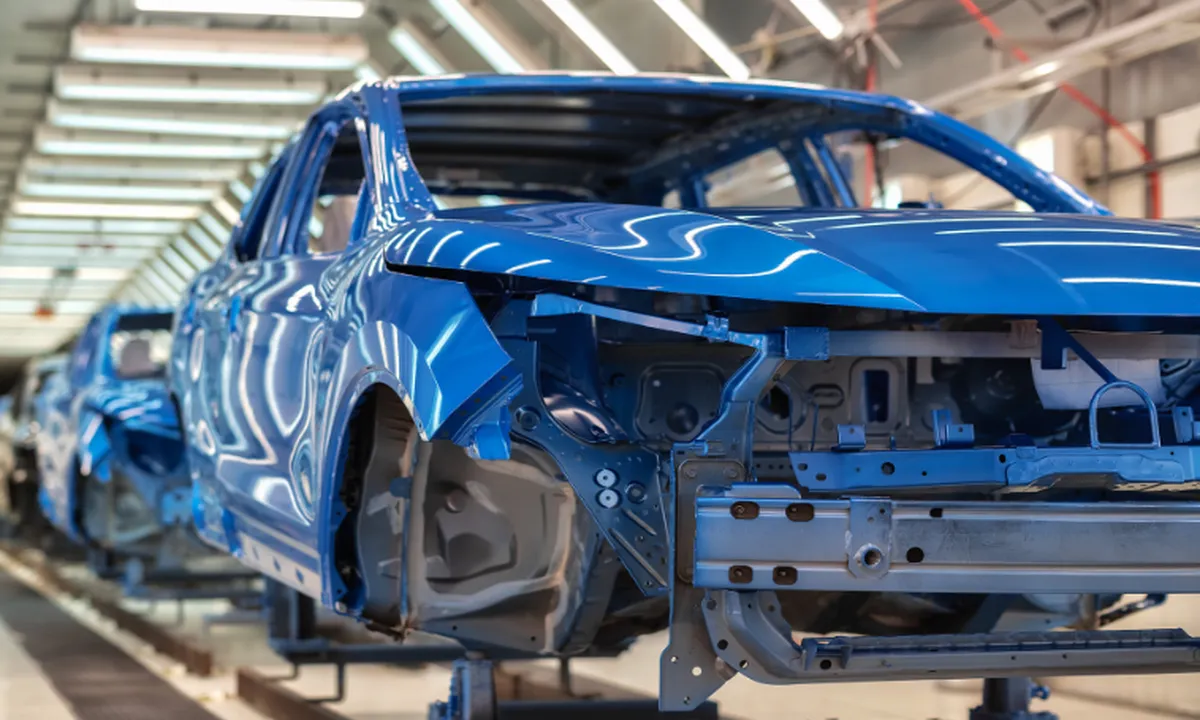 |  |
| Bevel Gear for Automotive Industry | Bevel Gear for Marine Industry |
 | 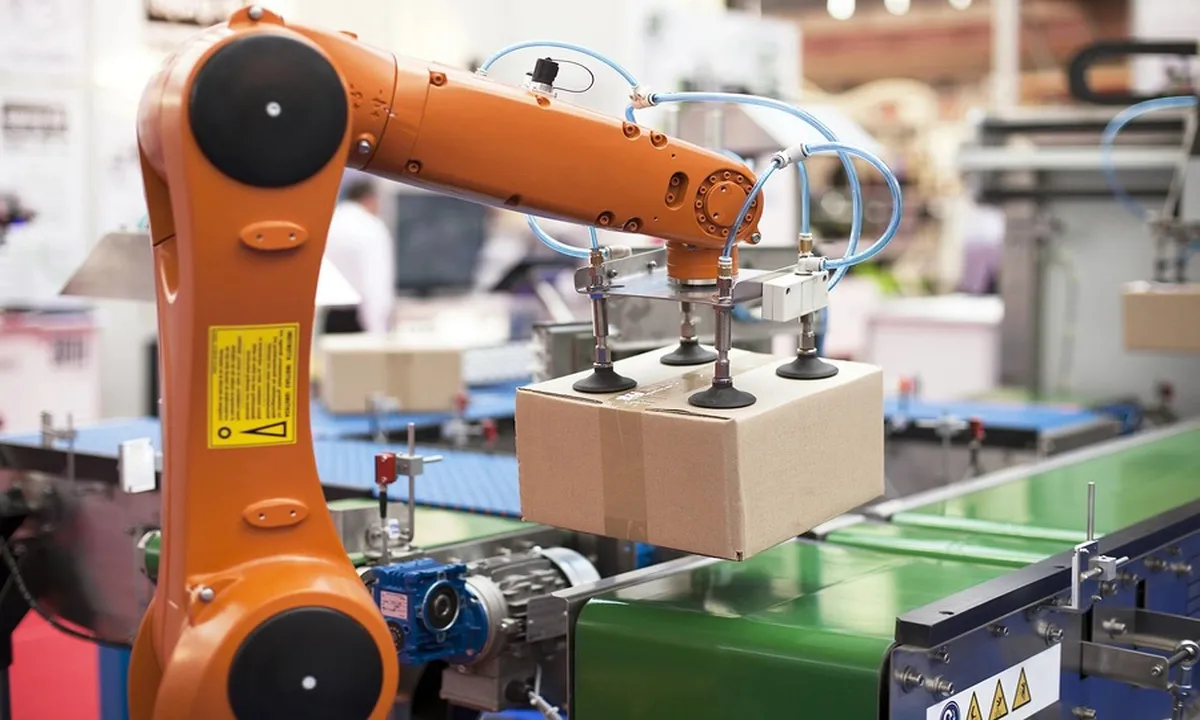 |
| Bevel Gear for Aerospace Industry | Bevel Gear for Robotics Industry |
Additional information
| Edited by | Yjx |
|---|
